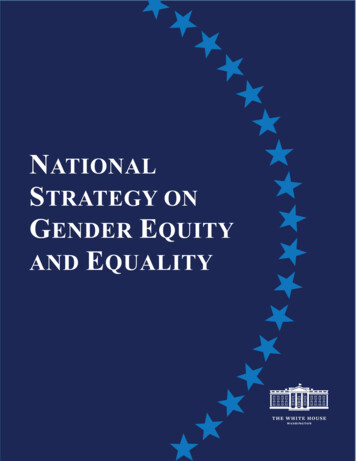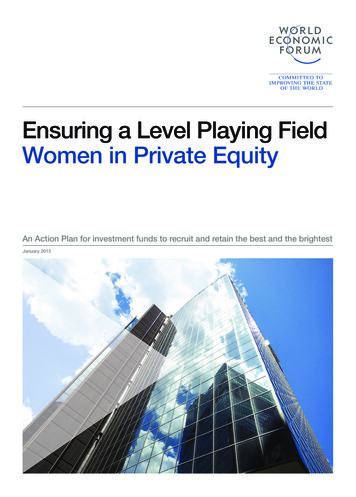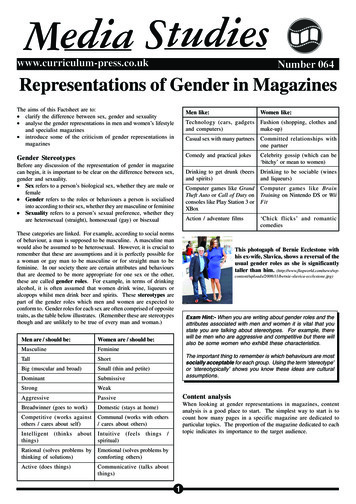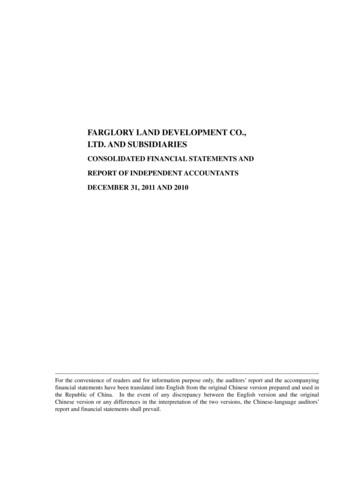
Transcription
NATIONALSTRATEGY ONGENDER EQUITYAND EQUALITY
National Strategy on Gender Equityand EqualityLetter from the President and Vice PresidentAmerica is unique among the nations of the world because we were built on an idea: that every one of usis equal in dignity and deserves to be treated equally. Though we have never fully lived up to that idea—not at the time of our founding, nor in the centuries since—it is the defining hallmark of our country thatwe have never stopped reaching for it. From the Emancipation Proclamation, to the passage of the 19thAmendment, to the Voting Rights Act and the Civil Rights Act, to the fight for reproductive rights andmarriage equality—and countless movements and victories before and since—America has beenstrengthened through the years by our tireless pursuit of greater equity for all.This document, the first-ever United States government strategy on gender equity and equality, is a part ofthat noble American tradition. It comes at an inflection point for the economic security, safety, health,and well-being of women and girls in our nation and around the globe. COVID-19 has exacerbated preexisting economic, health, and caregiving crises that disproportionately impacted women and girls longbefore the pandemic struck. Following the worst economic collapse since the Great Depression, women’sparticipation in the American labor force plummeted to its lowest level in over 30 years. Rates of genderbased violence have risen significantly, and racial and ethnic inequity has deepened. Globally, thepandemic has fueled increased economic insecurity for women and girls, and in far too many places—including, far too often, here in America — their fundamental rights remain at risk.This moment demands a bold and united response—a commitment to do more than just rebuild to a statusquo that wasn’t working for women and girls, but rather to build back better. We have already takenmajor strides, leading a strong and comprehensive response to COVID-19 both domestically and globally,getting our economy back on track, and centering equity in our recovery and response efforts, but we stillhave work to do to ensure equal opportunity for all people, regardless of gender. As we work to invest inthe American people and build an economy that deals everyone in, we have an unprecedented opportunityto chart a course for a future in which gender equity and equality are instilled in every part of our country,and—through our defense, diplomacy, foreign aid, and trade efforts—to advance the rights andopportunities of women and girls across the world.This effort is personal to us, as it has been throughout our lives and careers; as local elected officials andas U.S. senators, we each worked tirelessly to expand services and deliver justice to survivors of genderbased violence, fought for equal pay and against abuses of power, and helped craft legislation to bringgreater dignity to the lives of all workers. Now, as President and Vice President, our Administration iscarrying that work forward, making progress toward gender equity and equality a priority from day one.On the day that we were sworn in together, the Vice President toppled a barrier to women’s participationthat had stood for more than 200 years. Our Cabinet and senior staff are the most diverse and genderbalanced in history. And we have taken executive action aimed squarely at advancing equal opportunityregardless of gender, race, or any other characteristic. On International Women’s Day, the Presidentissued an Executive Order establishing the White House Gender Policy Council to ensure that genderequity and equality are at the forefront of America’s domestic and foreign policy. That Executive Orderalso mandated the development of this first-ever national strategy to guide our work on gender equity andequality as a government and as a nation.
This strategy outlines an ambitious agenda for this Administration and those to come—a roadmap to helpour nation close pernicious gender gaps and propel us toward a world with equal opportunity for allpeople. The restaurant worker organizing for fair wages. The migrant farmworker putting food on ourtables. The leader fighting for a place at the negotiating table where the future of their country will bedetermined. The girl studying hard, despite the barriers that stand in her way, to discover the next vaccineor scientific breakthrough in the fight against climate change. The single father who depends on paidleave to care for his family. The woman migrating with her children to flee gender-based persecution andseek a safer life. The transgender athlete who dreams of the chance to compete free from discrimination.The millions of frontline workers—disproportionately women—whose heroic work in our hospitals,grocery stores, schools, child care centers, domestic violence shelters, nursing homes, and elsewhere keptus going during one of the darkest periods in recent history. This strategy addresses barriers faced bythose who belong to underserved and historically marginalized communities that have long been deniedfull opportunity: women and girls of color, LGBTQI people, people with disabilities, and all of thosewhose lives are affected by persistent poverty and inequality.Ensuring that all people have the opportunity to live up to their full potential, regardless of gender identityor other factors, is not only a moral imperative. It is a strategic imperative—a continuation of our nationaljourney toward justice, opportunity, and equality set forth in our creation—that will advance prosperity,stability, and security at home and abroad in the years to come.
Table of ContentsSection I: Guiding Principles . 7Whole-of-Government Implementation . 8Intersectional Approach . 8Interconnected Priorities . 9Section II: Strategic Priorities . 10Improve Economic Security and Accelerate Economic Growth . 10Eliminate Gender-Based Violence . 14Protect, Improve, and Expand Access to Health Care, including Sexual andReproductive Health Care . 18Ensure Equal Opportunity and Equity in Education . 22Promote Gender Equity and Fairness in Justice and Immigration Systems . 24Advance Human Rights and Gender Equality Under the Law . 26Elevate Gender Equality in Security and Humanitarian Relief. 28Promote Gender Equity in Mitigating and Responding to Climate Change . 30Close Gender Gaps in Science, Technology, Engineering, and Mathematics Fields . 33Advance Full Participation in Democracy, Representation, and Leadership . 34Section III: Implementation . 38Whole of Government Implementation. 38Integration with Broader Equity Efforts. 38Methods . 39Accountability . 40Consultation and Engagement . 40Acknowledgements . 42
Section I: Guiding PrinciplesGender equity and equality are imperative to strengthening communities, economies, andnations. We envision a world where every person has equal opportunity; where their safety andsecurity are guaranteed; and where they are treated equitably and fairly at home and in theirschools, workplaces, and communities. In the face of multiple challenges, the Biden-HarrisAdministration is committed to building back better, rather than simply returning to thestatus quo.The status quo has not worked for women, girls, and all those who experience gender-baseddiscrimination—especially those who belong to underserved communities that have beensystematically denied full opportunity to participate in economic, social, civic, and political lifeand faced structural barriers to equality. Women’s work—both paid and unpaid—is oftenoverlooked and devalued, despite its critical role in the global economy. Gender-based violenceis endemic in homes, schools, workplaces, and communities, and far too often a hallmark ofconflict settings and humanitarian crises. Women and underserved groups are dramaticallyunderrepresented at decision-making tables. Gender inequity and inequality are rife across entirecommunities and nations.By contrast, the Biden-Harris Administration is building back better. We are addressing thediscrimination and structural barriers that have hampered women, especially women of color,from fully participating in the labor force and from being paid and treated equitably when theydo. We are tackling our country’s caregiving crisis head-on, including by investing in careinfrastructure and supporting the care workforce. We are addressing the pernicious effects ofhealth inequity and the need for access to quality, affordable health care, including sexual andreproductive health services, and we are focused on preventing and responding to gender-basedviolence wherever it occurs. We are working to eliminate longstanding disparities in oureducation, justice, and immigration systems.Building back better requires not just policy reform, but also a shift in the social and culturalnorms that undermine gender equity and equality, undervalue work traditionally anddisproportionately carried out by women, and prevent rights on paper from being fullyimplemented in practice. This kind of structural change is urgently needed as we recover from apandemic that has exacerbated economic, health, and caregiving crises, face the most significantreckoning over racial justice since the 1960s, and witness grave threats to reproductive rights andvoting rights.We are committed to American leadership on the world stage. Recent conflicts and crisesaround the world have demonstrated, once again, that times of acute instability and authoritarianresurgence reflect and exacerbate gender inequality and that full participation is critical tomeeting the global challenges we face. In Afghanistan, the universal human rights andfundamental freedoms of a generation of girls and women are in jeopardy, threatening the futureand security of the region. In Tigray, conflict-related sexual violence has been used as a tactic ofwar, further undermining stability. In Central America, women’s economic insecurity andgender-based violence contribute to the root causes of migration. Around the world, climatechange poses disproportionate risks to the health, safety, and economic security of womenand girls.NATIONAL STRATEGYONGENDER EQUITYANDEQUALITY7
At home and around the world, we are committed to ensuring that every individual is valued fortheir contributions in all fields, from classrooms to boardrooms; from sports fields to factoryfloors; from academia to the arts. We are dedicated to ensuring that they have increasedopportunities to serve as leaders and innovators in meeting the challenges ahead. We are alsocommitted to their full participation in political and civic life and their meaningful engagementin conflict resolution and peacebuilding during periods of conflict and crisis. As we work withlike-minded partners to defend democracy and human rights in the United States and around theworld at a time when democracy is under threat, we recognize that advancing gender equality iscentral to that mission and must be integrated throughout American defense, diplomacy, foreignaid, and trade efforts.Advancing gender equity and equality is therefore both a moral imperative and a strategic one;its pursuit drives the growth, development, and security of communities, nations, and the globaleconomy. To build back better, everyone—regardless of their gender or gender identity—musthave the opportunity to realize their full potential.This strategy is the first-ever U.S. national gender strategy, produced by the White HouseGender Policy Council, which will guide its implementation.Section One establishes the guiding principles that undergird our efforts to advance genderequity and equality. Section Two outlines ten strategic priorities, acknowledging and addressingtheir interconnection. Finally, Section Three elaborates on the whole-of-government effort thatis required for implementation, which will ensure that a focus on gender is mainstreamed acrossthe work of the federal government.Whole-of-Government ImplementationThis strategy is the product of and roadmap for a whole-of-government effort to advance genderequity and equality. Responsibility for realizing its bold vision is not the task of a sole agency orWhite House office, but rather a responsibility that cuts across the work of the Biden-HarrisAdministration in both domestic and foreign affairs.In order to mainstream gender equity and equality across our domestic and foreign policy, wewill elevate gender in strategic planning and budgeting, policy development, management andtraining, and monitoring and evaluation efforts. We will also strengthen data collection andanalysis and take steps to ensure transparency and accountability for progress toward the goalslaid out in this strategy.This work will be conducted in partnership with Congress, state, local, territorial, and Tribalgovernments, foreign governments and multi-lateral organizations, and non-governmentalactors—including faith-based groups, civil society, and private sector organizations—who werealso consulted in the development of the strategy and have an essential role in the work ahead.Intersectional ApproachThis strategy is part of the Biden-Harris Administration’s efforts to ensure that all people aretreated fairly and equitably and have the opportunity to reach their full potential. Therefore, itaims to address intersecting forms of discrimination and advance equity and equality.8NATIONAL STRATEGYONGENDER EQUITYANDEQUALITY
By equity, we refer to the consistent and systematic fair, just, and impartial treatment of allindividuals, including those who belong to underserved communities that have been denied suchtreatment, such as women and girls; Black, Latino, and Indigenous and Native Americanpersons, Asian Americans, Native Hawaiians, and Pacific Islanders, and other persons of color;members of religious minorities; lesbian, gay, bisexual, transgender, queer, and intersex(LGBTQI ) persons; persons with disabilities; persons who live in rural areas; and personsotherwise adversely affected by persistent poverty or inequality.By equality, we refer to the goal of reaching gender equality at home and abroad, meaning aworld in which equal opportunity is afforded to all people regardless of gender or anyother factor.This strategy reflects a commitment to address gender broadly. Our work is deeply motivated bya commitment to women and girls, in light of longstanding systemic discrimination and barrierswhich continue to affect their full participation and access to opportunity. We also combatdiscrimination and harmful gender norms that affect people of all genders: women and girls—including transgender women and girls—gender nonbinary and gender nonconforming people, aswell as men and boys.The strategy also addresses the impact of intersectional discrimination and bias on the basis ofgender, race, and other factors, including sexual orientation, ethnicity, religion, disability, age,and socioeconomic status. Intersecting challenges negatively impact individuals in underservedcommunities, including communities of color, in the United States and around the world. Ineach of the strategic priorities identified below, policies, programs and approaches will beinformed by the historical and current context of these overlapping burdens.Interconnected PrioritiesIn our efforts to advance gender equity and equality and further prosperity and stability at homeand abroad, we will focus on ten strategic priorities: (1) improving economic security andaccelerating economic growth; (2) eliminating gender-based violence; (3) protecting, improving,and expanding access to health care, including sexual and reproductive health care; (4) ensuringequal opportunity and equity in education; (5) advancing gender equity and fairness in the justiceand immigration systems; (6) advancing human rights and gender equality under the law; (7)elevating gender equality in security and humanitarian relief; (8) promoting gender equity inmitigating and responding to climate change; (9) closing gender gaps in science, technology,engineering, and mathematics (STEM) fields; and (10) advancing full participation indemocracy, representation, and leadership.We recognize that these ten priorities are interconnected. The education of girls affects theirfuture economic security and that of our nation. Gender-based violence, including sexualharassment and abuse, hampers economic and political participation and influences the healthand well-being of survivors. Restrictions on access to health care, including sexual andreproductive health services, undermine women’s ability to take care of their families, advancein the workplace, and lead in all sectors. Our strategic objectives are inherently linked and mustbe addressed in concert to achieve our vision for gender equity and equality.NATIONAL STRATEGYONGENDER EQUITYANDEQUALITY9
Section II: Strategic PrioritiesImprove Economic Security and Accelerate EconomicGrowthStrengthening women’s economic security and labor force participation is essential to advancinggender equity and equality. Simply put, our nation’s economy and the global economy cannotreach their full potential when half of the workforce is left behind. To achieve an equitablerecovery at home and abroad, we must ensure that all people have equal access to good, wellpaying jobs; address the persistent gender discrimination and systemic barriers to full workforceparticipation; invest in and strengthen the care infrastructure that our economy depends on; andpromote financial inclusion and close the gender wealth gap.In the United States and around the world, women, girls, and gender nonconforming people havelong faced systemic discrimination that has inhibited their full participation in the labor force,undermining their economic security, as well as that of their families. The COVID-19 pandemicexacerbated these challenges. Millions of women—many disproportionately concentrated inhard-hit sectors—lost their jobs or were forced to leave them to care for their families. In theUnited States, women’s labor force participation plummeted to its lowest level in over 30 years,with a disproportionate impact on women of color. Globally, women comprise only 39% of thelabor force but represented well over half of pandemic-related job losses around the world.The pandemic’s disproportionate impact on women’s economic security and labor forceparticipation stems from deep-seated, structural inequities in the workplace. In the United States,the barriers to access start at the door, with discrimination in hiring leading to unemployment,underemployment and occupational segregation. Globally, women’s labor force participationhas stagnated over the past two decades, with women disproportionately concentrated ininformal sector jobs and low-wage work. Nearly 100 nations have laws that inhibit women’seconomic participation—from limitations on the types of jobs they can hold to inequalities inproperty ownership—and in far too many nations, sexual harassment on the job remains legal.Furthermore, in nearly every country in the world, women earn less than men and do moreunpaid work. In the United States, the wage gap remains a stubbornly persistent problem. In2020, full-time year-round working women on average made only 83 cents on the dollar ascompared to men—with women of color paid even less. For example, Black women earned 64cents and Latinas earned 57 cents for every dollar earned by White men, with many Asianwomen, such as Vietnamese women earning similarly low wages. In 2019, the latest year forwhich data is available, Native women earned 60 cents for every dollar earned by White men.Responsibility for paid and unpaid care work also creates barriers and fuels discrimination thathold women back in the workforce, making improvement of our domestic and global careinfrastructure essential to advance women’s economic security and that of their families. Acrossthe world, even before the pandemic, women were responsible for nearly three-quarters ofunpaid care work on average, undermining their ability to participate in paid work. They alsomake up the vast majority of the care workforce. In the United States, nearly 95% of child care10NATIONAL STRATEGYONGENDER EQUITYANDEQUALITY
workers and 90% of home health care workers are women, disproportionately women of color,and the care workforce has been undervalued and underpaid for generations.The lack of affordable, accessible child care, elder care, and home care, as well as familysupportive policies including paid family and medical leave, has taken its toll, with the UnitedStates falling behind its competitors in the share of women in the labor force. Demand foraccessible, high-quality, affordable care is already high and only rising. Meanwhile, highcosts and increasing shortages of care for disabled and older adults leave many to rely on unpaidcaregiving, with more than one in six adult women serving as unpaid eldercare providers.Women also comprise the majority of caregivers to wounded, ill or injured service members andveterans. Women who bear the brunt of unpaid caregiving responsibilities often lack access tofamily-supportive policies in the workplace, and this is especially true for low-wage workers; theUnited States is one of the only countries in the world that does not guarantee any paid familyand medical leave, and over 90% of the lowest wage workers, who are predominately womenand workers of color, lack any access to paid family leave.The gaps in caregiving infrastructure have also contributed to the gender and racial wealth gaps,which are exacerbated by women’s broader exclusion from financial systems. Women facebarriers in access to consumer loans and other credit products, and women business owners haveless access to capital. These inequalities compound over the course of a woman’s lifetime,jeopardizing her financial security later in life and affecting the generations that follow. Acrossthe world, the effects of economic insecurity are profound; women are more likely to experiencepoverty, hunger, and housing instability. Their safety, too, is compromised, as economicinsecurity often keeps women trapped in abusive situations and increases vulnerability to abuse.The macroeconomic benefits of closing these gender gaps and supporting women’s participationin the labor force are clear. In the United States, experts found that the gains in women’searnings over the past 40 years drove 91% of the income gains experienced by middle-classfamilies. Estimates show that closing gender gaps in the workforce would add between 12 and 28 trillion in global GDP over a decade and addressing the gendered economic effects of theCOVID-19 pandemic alone would generate up to 13 trillion in global GDP by 2030.The full economic participation of women and girls is critical to our economic competitiveness.As part of our commitment to foster an equitable economic recovery and build back better forall, we will:a. Promote Economic Competitiveness by Advancing Women’s Employment in WellPaying JobsTo strengthen U.S. economic competitiveness and support working families, we will ensure thatwomen have the support they need to enter, stay, and advance in the labor force, and encouragetheir access to well-paying, good quality jobs. We will also work to ensure that women have afree and fair choice to join a union and that domestic workers receive the legal benefits andprotections they deserve. We will seek increased pay for jobs that are disproportionately held bywomen by pursuing an increase in the minimum wage and the elimination of the tippedminimum wage and the subminimum wage for all workers, including those with disabilities.To promote entrepreneurship and innovation, we will reduce gender discrimination in businessand consumer lending and close persistent gender gaps in access to capital by catalyzinginvestment in women-owned businesses, including small and medium-sized enterprises, in theNATIONAL STRATEGYONGENDER EQUITYANDEQUALITY11
domestic and global marketplace. This includes promoting data collection and transparency inthe financial, technology, and venture capital sectors to track the proportion of investments inwomen-led businesses, as well as the collection of sex-disaggregated data on asset ownership atthe household level to track the gender wealth gap.To ensure equitable access to 21st century jobs of the future, we will support access to highquality careers, technical education, and community college, and increase the maximum PellGrant to make postsecondary education affordable for low-income students. We will alsosupport high-quality job training to make critical labor skills available irrespective of gender andwithout the burden of debt. We will work to broaden access to gender equitable workforcedevelopment programs, such as registered apprenticeships and pre-apprenticeships, andstrengthen programs that help expand pathways for women to enter, re-enter, and lead in allindustries, including non-traditional occupations and STEM fields. We will strengthen supportfor military spouses, the vast majority of whom are women, to find and sustain employment,recognizing the challenges facing highly-mobile military families. We will support efforts toaddress how gender norms and outdated workplace practices fuel occupational segregation anddevalue work in industries disproportionately populated by women. Furthermore, we will workto address the rise in automation and insecure work arrangements—from the growth inindependent contracting to the erosion of unions and workers’ rights—in ways that are genderequitable, recognizing that women workers are disproportionately vulnerable to these trends.Globally, we will promote women’s access to good-paying, decent jobs in the formal sector andaddress the overrepresentation of women in the informal economy, including by promotingsourcing and procurement from women-owned business. We will also support workforcedevelopment and training to advance women’s representation in non-traditional sectors, such asSTEM and construction. We will promote women’s economic opportunities through bilateraland multilateral diplomacy and foreign assistance, with a focus on ensuring women have thecapabilities and resources needed to participate in the economy; access to well-paying jobs andleadership roles; and the social and institutional supports required to compete in the workplace.We will also promote efforts to confront gender stereotypes that devalue women’s work aroundthe world.b. Address Persistent Gender Discrimination and Systemic Barriers to Full WorkforceParticipationTo close the gender wage gap in the United States, we will work to strengthen laws prohibitingwage discrimination on the basis of gender, race, and other characteristics, and will increaseresources for enforcement. We will also promote pay transparency, taking steps to increaseanalysis of pay gaps on the basis of gender, race, and other factors, and outline plans to eliminatethese disparities. We will pursue policies to eliminate reliance on prior salary history incompensation decisions, which can perpetuate and compound the effects of prior discrimination.Furthermore, we will support policies to prohibit discrimination against pregnant and parentingworkers. We will also work to ensure fair and flexible scheduling practices and access to paidsick days.We will aim to eliminate harassment and other forms of discrimination in the workplace,including sexual harassment. This includes increasing transparency and accountability by endingforced arbitration and mandatory nondisclosure agreements that prevent workers from pursuing12NATIONAL STRATEGYONGENDER EQUITYANDEQUALITY
their day in court and by strengthening prevention efforts to create a work environment where allworkers can thrive.The federal government, as the nation’s largest employer, will update policies and programs toprevent and address sexual harassment and other forms of harassment and discrimination acrossthe federal workforce and our armed services, including supports for survivors. We will alsoaddress barriers to reentry into the labor force from the criminal justice system, particularly thosebarri
National Strategy on Gender Equity and Equality Letter from the President and Vice President A










